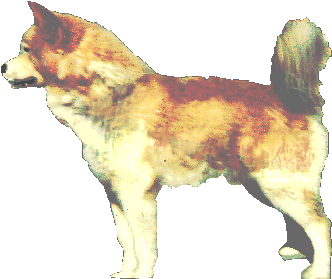Occasionally Malamutes (of any color)
that have face markings which include a "blaze" (or white stripe
down the muzzle) may often evidence a pinkish stripe on their
nose. Usually termed a "snow nose", and, again, occurring off
and on throughout the seasons; this is not a sign of poor pigment
ation, provided the lips have a nice dark pigment.
While some
of these colors have previously been "frowned upon" at shows and even culled
from litters, none of these colors are against the breed
standard. Many of the lines producing dogs with the red
factor originate from the second opening of the stud book
following WWII, when in 1947, it was discovered that a less
than adequate supply of original Kotzebue bloodstock remained.
This M'Loot type had been bred by Paul Voelker of Minnesota in
the 1930's and 40's and his Malamutes were accepted by AKC upon
completion of their Championships.
Breeders since that
time have rallied to one side or the other, but key seemed to be
blending of the two lines. The remaining Kotzebues were of
good type, with good heads and proportions, although standing
smaller than the original freighting Malamute. Tending to be
uniformly grey in color, Kotzebues were generally more tractable
and less aggressive to other dogs.
Conversely the original
M'Loot's, though of greater size, tended to be somewhat more
rangy. They were less uniform and often had longer ears and
muzzles. Breeders, like Zoller's at Husky Pak Kennel and
Schmitts of Silver Sled Kennel, with the foresight to cross the
early original lines benefited from the blending. The resulting
Malamutes showed an overall refinement of the rangy M'Loot
type- the good hindquarters of the Kotzebue's, balanced with the
powerful fronts of larger M'Loots.
Dogs with M'Loot lines,
while transmitting the red genetics, can tend to be more
aggressive with others dogs, vocal and difficult to handle. The
key to successful breeding of these colors lies in maintaining
pigmentation and temperment.

 Click here to send us an email message
Click here to send us an email message


 shadings of brown, buff, mahogany,
shadings of brown, buff, mahogany,


 In certain
seasons, may show evidence of a reddish mask under the black
face markings, and/or, creamy red tones to the undercoat.
In certain
seasons, may show evidence of a reddish mask under the black
face markings, and/or, creamy red tones to the undercoat.

 If you see diluted red coloring on the topline
and tail and distinct liver or brown pigmentation, the dog is,
in fact, a very light red.
If you see diluted red coloring on the topline
and tail and distinct liver or brown pigmentation, the dog is,
in fact, a very light red.


 If both parents are white, with black pigment, the litter will tend to consist
of all white pups, (see the litter shown in "This is the Alaskan Malamute").
Theoretically, breeding white to white can produce
any of the various colors in this breed,
but generally you will see an entirely white litter.
If both parents are white, with black pigment, the litter will tend to consist
of all white pups, (see the litter shown in "This is the Alaskan Malamute").
Theoretically, breeding white to white can produce
any of the various colors in this breed,
but generally you will see an entirely white litter.
![]()
![]() Click here to send us an email message
Click here to send us an email message